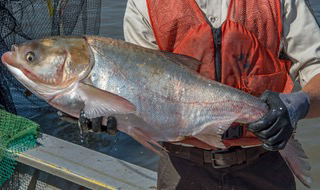Silver Carp Fitted with Tracking Devices on Mississippi River
As part of extensive efforts to prevent the spread of invasive carp, four silver carp were recently captured, fitted with tracking devices and released in Pool 8 of the Mississippi River near La Crosse, Wisconsin.
A commercial fishing operation contracted by the Minnesota Department of Natural Resources to conduct netting in the area captured the invasive carp. Contract commercial netting operations will continue this fall while river conditions permit.
The recent netting operation came in response to captures of invasive carp in Pool 8 during spring carp surveillance. The DNR is working with the U.S. Fish and Wildlife Service, the U.S. Geological Survey, the Wisconsin DNR and commercial fishing operators to conduct large-scale netting, studies of the captured carp, and increased monitoring.
When notified of the recent carp captures, specialists with the USFWS quickly mobilized to fit the carp with tracking devices and get them back into the river. While individual invasive carp have been previously tagged and tracked in Minnesota and Wisconsin waters of the Mississippi, this is the first time more than one has been tagged in a single operation.
Along with continued netting and monitoring, the four newly tagged silver carp will be tracked to learn more about their movements and habits.
“The more we can learn about these fish, the more effectively we can work to prevent their spread,” said DNR invasive fish coordinator Nick Frohnauer. “The ability to now track four silver carp gives us important data not only about how they act individually but also how they might move together and among schools of other fish.”
Invasive carp have been progressing upstream since escaping into the Mississippi River in Arkansas in the 1970s. These large fish compete with native species and pose a threat to rivers and lakes. No breeding populations have been detected in Minnesota waters to date. Individual invasive carp have been caught as far upstream as Pool 2 of the Mississippi, near the Twin Cities (bighead, grass, and silver), the King Power Plant on the St. Croix River by Oak Park Heights (bighead), and just downstream of Granite Falls in the Minnesota River (bighead).
Prior to last spring, all of the invasive carp captured in Minnesota had been single fish or small numbers of fish. Higher numbers earlier this year likely were related to prolonged high water conditions during the summer of 2019.
During high water, gates at the locks and dams on the river remain open to allow flood waters to pass. These “open river” conditions allow easier upstream movement of fish from downstream portions of the river. Since then, water levels have receded, reducing the opportunity for invasive carp to move through locks and proceed upriver.
The DNR has built partnerships with state and federal agencies, conservation groups, university researchers and commercial businesses to prevent the spread of invasive carp. The 2015 closure of the Mississippi River lock at Upper St. Anthony Falls in Minneapolis was a major accomplishment in these efforts.
The DNR is actively engaged with several prevention efforts:
- The DNR is an active partner in the Upper Mississippi River Invasive Carp Workgroup. The group includes representatives from Minnesota, Wisconsin, Iowa, Illinois, Missouri, and several federal agencies.
- In partnership with the DNR, the Minnesota Aquatic Invasive Species Research Center at the University of Minnesota is testing and evaluating carp deterrents in Mississippi River locks and dams. Currently, the University of Minnesota is also consulting on a sound, bubble and light deterrent at Barkley Lock and Dam in Kentucky. Carp are sensitive to sound and light, and curtains of bubbles may also inhibit their movement.
- The DNR’s Fish and Wildlife Division leads a program to monitor fish population changes and impacts of management actions. This includes maintaining relationships with commercial fishing operators.
State funding sources, including the Environmental and Natural Resources Trust Fund and the Outdoor Heritage Fund, have provided key funding for deterrent actions and the DNR invasive carp detection and response program.
Invasive carp captures must be reported to the DNR immediately. People capturing an invasive carp should call 651-587-2781 or email invasivecarp.dnr@state.mn.us. Take a photo and transport the carp to the nearest DNR fisheries office or make arrangements for it to be picked up by a DNR official. Do not release captured invasive carp. A permit can be requested, to keep captured invasive carp for personal use.
More information about invasive carp is available on the DNR website.





